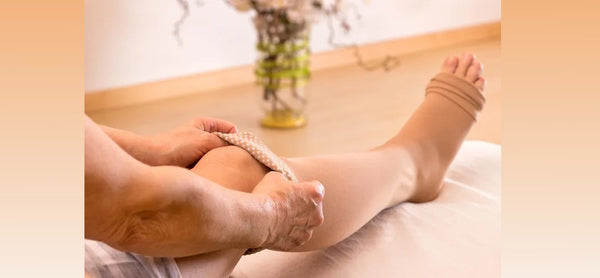
Should I be wearing compression sock/stockings
Compression socks are not just for athletes or individuals with medical conditions. In fact, they can benefit a wide range of people in various situations. Let's explore who should consider wearing compression socks.
1. Travelers
Individuals who travel frequently, especially on long flights or car rides, can benefit from wearing compression socks. Sitting for extended periods can lead to poor circulation and swelling in the legs. Compression socks can help improve blood flow and reduce the risk of blood clots during travel.
2. Pregnant Women
Pregnant women often experience swelling in their legs and feet due to increased pressure on the veins. Compression socks can provide support and help alleviate discomfort by promoting better circulation.
3. Workers Who Stand All Day
Professions that require standing for long hours, such as nurses, teachers, and retail workers, can benefit from wearing compression socks. These socks can help reduce fatigue, swelling, and discomfort in the legs and feet by improving circulation.
4. Athletes
Athletes, especially runners, cyclists, and triathletes, can benefit from wearing compression socks during training and recovery. Compression socks can help improve performance, reduce muscle soreness, and speed up recovery by increasing blood flow and oxygen delivery to the muscles.
5. Individuals with Medical Conditions
People with medical conditions such as varicose veins, deep vein thrombosis (DVT), lymphedema, or diabetes may benefit from wearing compression socks as part of their treatment plan. Compression socks can help manage symptoms, reduce swelling, and improve overall circulation.
Whether you're a frequent traveler, a pregnant woman, a standing worker, an athlete, or someone with a medical condition, wearing compression socks can provide numerous benefits. Consult with a healthcare professional to determine if compression socks are right for you.
Benefits of Compression Socks
Compression socks can help your body in many ways when you wear them correctly. Their main purpose is to improve your circulation, which keeps oxygen-rich blood flowing in your body.
Compression stockings can also:
- Help prevent and reduce pain and discomfort in your legs
- Reduce swelling in your legs, feet, and ankles
- Lessen muscle strain when exercising, which helps you recover faster
- Protect against blood clots when you sit or stand for long periods
- Lessen dizziness when you stand up
- Support your veins to prevent or treat spider and varicose vein
Types of Compression Stockings
Compression socks and stockings come in different lengths and pressures to cover different parts of your body. For DVT, most stockings go to just below the knee, but you can get thigh-highs and waist-length tights, too.
They also have different levels of pressure, measured in mmHg (millimeters of mercury). Stockings should feel snug, but not painfully tight. Mild compression, with lower numbers, is usually enough to keep you comfortable on your feet at work. You'll need higher numbers with a firmer fit to prevent DVT.
There are two common types of compression socks:
Graduated compression stockings. This type is more common. You can find them in a wide range of tightness. They tend to be tighter around your ankles and get looser the higher they go up your leg.
Thrombo-embolic deterrent (TED) hose or anti-embolism stockings. These are designed to help maintain your blood circulation and lower the odds of severe swelling. They're mostly used after surgery and when you need to stay in bed.
If you need the stockings for medical reasons, your doctor will measure your legs and prescribe the right ones for you.
How to Pick Compression Stockings
If it’s your first time trying compression socks or stockings, it's best to talk to you doctor or health care provider about what type you need.
Here are some tips on how to choose the right compression stocking for you.
Pick the right type. To get the most of out of compression socks, find ones that fit you well and are the correct length. For example, if you buy graduated compression stockings from a store but they aren’t working well enough, you might need to upgrade to prescription-grade stockings. Or you might need to adjust or wear them properly. Talk to your doctor about it. They can help you figure out the right fit and pressure.
Pick one that fits right. Before you pick a stocking, measure the length and girth of your ankle, calves, and leg if you’re opting for thigh-high or waist-high leggings.
How to Wear Compression Stockings
To get the most out of your compression stockings, you need to be sure you're wearing them correctly. When you put them on, be sure they're smooth and they lie flat against your skin and avoid bunching.
Make sure they aren't too long. Don't fold or roll the tops down, because that can make them too tight. It could cause blood flow problems or cut off your circulation like a tourniquet. You can wear socks, slippers, and shoes over compression stockings.
You can wear prescribed compression stockings all day and sometimes even all night. You can take them off to shower or bathe.
Should you sleep with compression stockings?
For over-the-counter compression socks, there’s often no benefit to wearing them overnight. Taking them off overnight gives your skin a break to avoid damage.
If you have prescribed compression stockings for medical use, your doctor may tell you to wear them overnight. When it comes to sleeping in compression stockings, follow your doctor’s advice.
Tips for First-Time Compression Stocking Users
If you're trying out compression socks for the first time, you might find them a little difficult to manage. To make them a easier to put on, here are a few tips you should consider.
- Wear the stockings first thing in the morning when your legs are less likely to be swollen.
- Roll the stockings inside out to the ankle. Slip your feet in and slowly roll them up your legs and smooth out the fabric to avoid snags.
- If you’re wearing thigh-highs or leggings, stand up to pull them up past your knees.
- Try wearing rubber gloves while you put on your stockings so you can get a better grip on them.
- Don't wear any jewelry that could tear or snag your compression socks when you're putting them on.
- Avoid applying lotion or oils right before you wear the stockings. Moisture makes it harder to pull stockings on.
- Wash new stockings in mild soap before you wear them. It makes the fabric pliable and easier to wear.
- If you can, buy more than one pair so you have a clean pair while one is dirty.
When you first put them on, compression socks or stockings might feel uncomfortable and make your legs ache or feel sore. This is normal, and you should get used to them after a few wears. But if you have extreme pain, or your legs or feet become discolored, call your doctor right away.
Side Effects of Wearing Compression Stockings
Compression stockings can have some side effects, especially if you're not wearing them correctly or you're wearing the wrong size. The most common side effects include:
- Skin irritation, such as itchiness or feeling cold or warm
- Redness
- Pain or discomfort
Rare side effects include:
- Allergic reaction to the stocking material
- Bacterial or fungal infection
- Soft tissue damage
Side effects often happen when you don’t have properly sized stockings or wear them incorrectly. If the top of the stocking at the thigh or calf is too tight, it can create a tourniquet effect. This actually blocks or slows your blood flow.
You shouldn't wear compression socks if you have severe peripheral artery disease (PAD) because it makes the blood vessels in your legs narrow, reducing your blood flow.
Written by Patricia Chaney, WebMD Editorial Contributor

